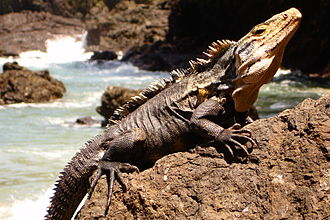Type the name of the breed you're looking for below
[wpdreams_ajaxsearchlite] Don't see the breed your're looking for? Click here and let us know!
Spiny Tailed Iguana
| Place of Origin and Range | Ctenosaura similis, commonly known as the black spiny-tailed iguana, black iguana, or black ctenosaur, is a lizard native to Mexico and Central America that has been introduced to the United States in the state of Florida. |
| Description | Black spiny-tailed iguana have distinctive keeled scales on their long tails, which gives them their common name. They have a crest of long spines which extends down the center of the back. Although colouration varies extremely among individuals of the same population, adults usually have a whitish gray or tan ground colour with a series of 4–12 well-defined dark dorsal bands that extend nearly to the ventral scales. Males also develop an orange colour around the head and throat during breeding season with highlights of blue and peach on their jowls. |
| Morph Patterns Available | Yes |
| Adult Size | Can grow up to 4 feet (1.2 m) |
| Accommodation | Most Iguanas will thrive only in temperatures of 79 °F (26 °C) to 95 °F (35 °C) and must have appropriate sources of UVB and UVA lighting, or else their bodies cannot produce vitamin D that promotes calcium absorption, which can result in a metabolic bone disease that can be fatal. A large enclosure and access to fresh water. 6 f x 6 f x 30 inches. |
| Lifespan | Can live 12- 15 years |
| Feeding / Diet | This Iguana is primarily herbivorous, consuming leaves, flowers, berries, and fruits from different plant species, has been known to accept insects and even mice. |
| Breeding | Mating generally occurs in the spring. Males show dominance and interest by head bobbing; eventually the male will chase the female until he can catch her and subdue her. Within eight to ten weeks, the female will dig a nest and lay clutches of up to 30 eggs. The eggs hatch in 90 days with the hatchlings digging their way out of the sand. These juveniles are typically green with brown markings, although all brown hatchlings have been recorded as well. |



